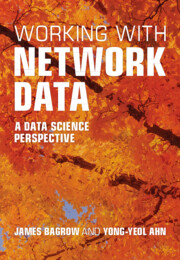148 results
Session-effects in the laboratory
-
- Journal:
- Experimental Economics / Volume 15 / Issue 3 / September 2012
- Published online by Cambridge University Press:
- 14 March 2025, pp. 485-498
-
- Article
- Export citation
Impact of Seismic Activities on the Optical Synchronization System of the European X-ray Free-Electron Laser
-
- Journal:
- High Power Laser Science and Engineering / Accepted manuscript
- Published online by Cambridge University Press:
- 05 March 2025, pp. 1-14
-
- Article
-
- You have access
- Open access
- Export citation
WALLABY Pilot Survey: HI source-finding with a machine learning framework
-
- Journal:
- Publications of the Astronomical Society of Australia / Volume 42 / 2025
- Published online by Cambridge University Press:
- 10 February 2025, e033
-
- Article
-
- You have access
- Open access
- HTML
- Export citation
Correspondence Analysis of Incomplete Contingency Tables
-
- Journal:
- Psychometrika / Volume 53 / Issue 2 / June 1988
- Published online by Cambridge University Press:
- 01 January 2025, pp. 223-233
-
- Article
- Export citation
Statistical Analysis of Sets of Congeneric Tests
-
- Journal:
- Psychometrika / Volume 36 / Issue 2 / June 1971
- Published online by Cambridge University Press:
- 01 January 2025, pp. 109-133
-
- Article
- Export citation
Comment on “Correspondence Analysis used Complementary to Loglinear Analysis”
-
- Journal:
- Psychometrika / Volume 53 / Issue 2 / June 1988
- Published online by Cambridge University Press:
- 01 January 2025, pp. 287-291
-
- Article
- Export citation
A PROC MATRIX Program for Preference-Dissimilarity Multidimensional Scaling
-
- Journal:
- Psychometrika / Volume 51 / Issue 1 / March 1986
- Published online by Cambridge University Press:
- 01 January 2025, pp. 163-170
-
- Article
- Export citation
Correspondence Analysis used Complementary to Loglinear Analysis
-
- Journal:
- Psychometrika / Volume 50 / Issue 4 / December 1985
- Published online by Cambridge University Press:
- 01 January 2025, pp. 429-447
-
- Article
- Export citation
On the Precision of a Euclidean Structure
-
- Journal:
- Psychometrika / Volume 44 / Issue 4 / December 1979
- Published online by Cambridge University Press:
- 01 January 2025, pp. 395-408
-
- Article
- Export citation
The Principal Components of Mixed Measurement Level Multivariate Data: An Alternating Least Squares Method with Optimal Scaling Features
-
- Journal:
- Psychometrika / Volume 43 / Issue 2 / June 1978
- Published online by Cambridge University Press:
- 01 January 2025, pp. 279-281
-
- Article
- Export citation
Multidimensional Scaling of Nominal Data: The Recovery of Metric Information with Alscal
-
- Journal:
- Psychometrika / Volume 43 / Issue 3 / September 1978
- Published online by Cambridge University Press:
- 01 January 2025, pp. 367-379
-
- Article
- Export citation
Additive Structure in Qualitative Data: An Alternating Least Squares Method with Optimal Scaling Features
-
- Journal:
- Psychometrika / Volume 41 / Issue 4 / December 1976
- Published online by Cambridge University Press:
- 01 January 2025, pp. 471-503
-
- Article
- Export citation
Nonmetric Individual Differences Multidimensional Scaling: An Alternating Least Squares Method with Optimal Scaling Features
-
- Journal:
- Psychometrika / Volume 42 / Issue 1 / March 1977
- Published online by Cambridge University Press:
- 01 January 2025, pp. 7-67
-
- Article
- Export citation
Three Notes on ALSCAL
-
- Journal:
- Psychometrika / Volume 43 / Issue 3 / September 1978
- Published online by Cambridge University Press:
- 01 January 2025, pp. 433-435
-
- Article
- Export citation
Graph-based information management for retrofitting long-living assets
-
- Journal:
- Data-Centric Engineering / Volume 5 / 2024
- Published online by Cambridge University Press:
- 20 December 2024, e46
-
- Article
-
- You have access
- Open access
- HTML
- Export citation
8 - Muddied waters: The challenge of confounding
-
- Book:
- Essential Epidemiology
- Published online:
- 27 September 2024
- Print publication:
- 12 November 2024, pp 187-211
-
- Chapter
- Export citation
Chapter 7 - Extracting networks from data — the “upstream task”
- from Part II - Applications, tools, and tasks
-
- Book:
- Working with Network Data
- Published online:
- 06 June 2024
- Print publication:
- 13 June 2024, pp 83-88
-
- Chapter
- Export citation

Working with Network Data
- A Data Science Perspective
-
- Published online:
- 06 June 2024
- Print publication:
- 13 June 2024
Advancing digital healthcare engineering for aging ships and offshore structures: an in-depth review and feasibility analysis
-
- Journal:
- Data-Centric Engineering / Volume 5 / 2024
- Published online by Cambridge University Press:
- 03 June 2024, e18
-
- Article
-
- You have access
- Open access
- HTML
- Export citation
The epidemiology of errors in data capture, management, and analysis: A scoping review of retracted articles and retraction notices in clinical and translational research
-
- Journal:
- Journal of Clinical and Translational Science / Volume 8 / Issue 1 / 2024
- Published online by Cambridge University Press:
- 17 May 2024, e110
-
- Article
-
- You have access
- Open access
- HTML
- Export citation



